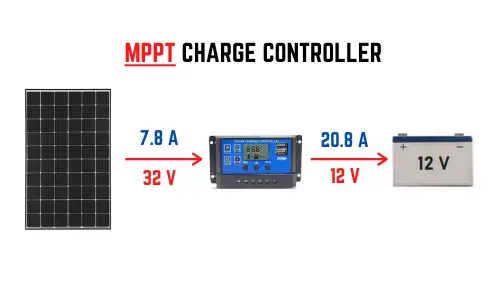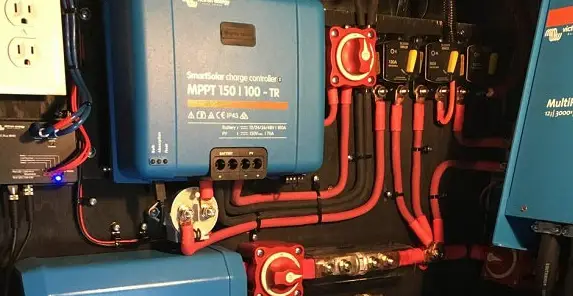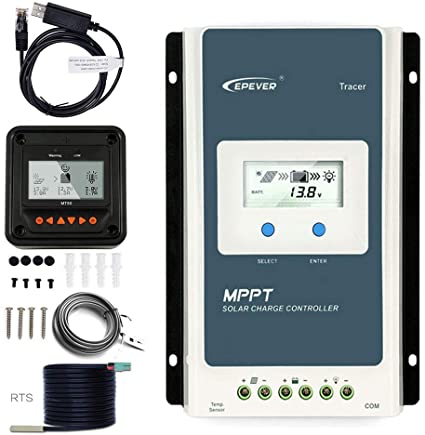In this quick guide, we’ll show you how to size a solar MPPT charge controller properly.
Even though it’s a relatively small device, sizing it wrong or for PWM by accident can lead to your solar system being damaged due to over-current or over-voltage.
In the end, we’ll also answer some commonly asked questions
WHAT DO SOLAR MPPT CHARGE CONTROLLERS DO?

In short, solar charge controllers prevent the overcharging of solar batteries by limiting the amount of power that goes to your batteries—if not defined, the battery can be damaged, or overtime, its life length can be shortened. An MPPT charge controller is the most efficient and ideal controller out there for larger appliances and the most expensive.
HOW DO I SIZE A MPPT CHARGE CONTROLLER?
MPPT charge controllers limit their outputs, so even if your solar panels have a higher potential to produce some amount of current – for example, 100 Amps – a 50-amp charge controller will only allow 50 Amps to get by the controller.
Properly sizing a charge controller isn’t rocket science—in fact, there are plenty of online calculators you can use to know what “size” MPPT charge controller is suitable for your solar system. Explorist Life has a detailed calculator that will ask for properties such as solar panel Wattage, battery bank Voltage, air temperatures, and much more.
For a less detailed calculator to get you a solar MPPT charge controller that’s within the ballpark for your solar system, try Victron Energy’s solar MPPT charge controller calculator.
HOW DO I SIZE A CHARGE CONTROLLER MANUALLY?

Suppose you don’t want to use an online calculator to size your solar MPPT charge controller, no worries! There are many formulas to help you out. A solar MPPT charge controller is usually rated in 3 ratings:
- The first rating is simply just what the Voltage of the battery bank is. If your battery bank is rated at 12V, get a 12V solar MPPT charge controller.
- The second rating is the Voltage input. The formula is:
Voltage = “Voc of solar panel” x “number of panels” x “temp. coefficient”
| Temperature (°F) | Temp. Coefficient |
| 76 – 68 | 1.02 |
| 67 – 59 | 1.04 |
| 58 – 50 | 1.06 |
| 49 – 41 | 1.08 |
| 40 – 32 | 1.10 |
| 31 – 23 | 1.12 |
| 22 – 14 | 1.14 |
For example, suppose your solar panels have a Voc of 24V. In that case, if you have four solar panels in series, and if it’s 55 °F outside, you’ll find the temperature on the table above and enter the corresponding coefficient into the formula:
24V x 4 panels x 1.06 = 102V
This setup would be great for a 102-Volt input charge controller.
3. The third rating is the output current. This is simply just the Wattage divided by the Volts. For example, if you have a 2,000-Watt solar array with a 24-Volt battery bank, that’s a current of 83.3 Amps. This means that the rating of the solar charge controller must be at least 80 Amps.

WHAT HAPPENS IF I SIZE A CONTROLLER WRONG?
If you use a solar MPPT charge controller that’s under the correct size, you might not get as much out of your solar system as expected.
However, suppose your charge controller is sized over. In that case, it may allow more current and Voltage into your solar battery, which could damage your battery and render your charge controller useless.
If you accidentally size it for a pulse width modulation, or PWM, charge controller, things could get rough. Since PWM charge controllers cannot limit their current output, you might get too much current into your solar system, which could also damage the battery and your solar charge controller.
You can always use a PWM charge controller, but ensure your design is optimized for PWM charge controllers. Always double-check to make sure you’re using the right one!
COMMON APPLIANCES AND CURRENT LOADS
Your solar system may be powering many appliances, so it’s essential to know the current load for each machine, especially for charge controllers. Down below is a table of a few of the most common household appliances and their respective average current and average load from DIY Help:
| Appliance | Average Amps | Average Load in Watts |
| Ceiling Fan | 0.4 | 50 |
| Washing Machine | 12.5 | 1,500 |
| Computer | 6 | 670 |
| Hair Dryer | 8 | 900 |
| Television | 2.5 | 300 |
| Coffee Maker | 9 | 720 |
| Clock Radio | 0.8 | 100 |
For example, if you had one of each item listed above, you can add up the average Amps, which would be 39.2—a 40-Amp MPPT charge controller would be perfect in this case.
COMMON FREQUENTLY ASKED QUESTIONS
There are many common questions that new charge controller users ask, and we’re here for them! Down below, you’ll find a list of questions and answers to the best of our abilities.
What’s the main difference between PWM and MPPT charge controllers?
A PWM controller is a controller that lets the solar battery fill slightly above that perfect percentage of battery charging. This is to let the appliances have bulk power and run more efficiently and smoother. A PWM controller is recommended for lighter loads and smaller devices.
An MPPT charge controller can be thought of as a smart DC-DC converter that lets the battery charge to that perfect charging point and no more. It’s brilliant because almost everything is done automatically! An MPPT controller is used for bigger appliances and a larger power drawing.
Can you use more than one charge controller?
Yes, you can use more than one charge controller!
The battery bank’s Voltage must be lower than your array Voltage so that your solar system can be charged. In other words, it’s better to connect a set of solar panels to a charge controller and another set of panels to another controller that both go to the battery rather than connecting two charge controllers in series.
What’s the upper voltage limit on a charge controller?
All charge controllers have some sort of an upper Voltage limit. This is the maximum amount of Voltage that the controllers can handle from solar panels. This value can be found right on the box of the charge controller or within the guide or specifications pamphlet that it comes with.
What are some common mistakes that people make with charge controllers?
Although the process may seem simple, sometimes, things can be complex with all of the components, and mistakes are easily made. Here are some common mistakes that users make with charge controllers:
- Do not connect AC loads to the charge controller: Solar panels bring in DC power which is the only type of power going to a charge controller.
- Low-Voltage appliances must be directly connected to the battery: Rarely, a low-voltage appliance shouldn’t be directly connected to the battery.
- Connect the charge controller as close as possible to the battery: With wire sizing and length, some power can be lost if the charge controller is connected too far from the battery.
WRAPPING UP
Remember always to double-check any connections made! It’s never a bad idea to run the math yourself and then through an online calculator as a second opinion to make sure that you correctly sized your MPPT charge controller. Be safe and good luck!
